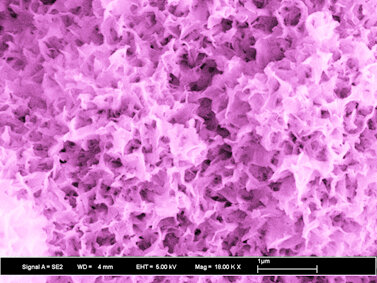An interdisciplinary research team at Lehigh University has unraveled how functional biomaterials rely upon an interfacial protein layer to transmit signals to living cells concerning their adhesion, proliferation and overall development.
According to an article published today in Scientific Reports, the nanoscale features and properties of an underlying substrate do not impact the biological response of cells directly. However, these properties indirectly influence cell behavior through their control over adsorbed proteins.
In the article, “Nanostructure of bioactive glass affects bone cell attachment via protein restructuring upon adsorption,” the Lehigh team demonstrates that living cells respond to interfacial layer characteristics that arise as a consequence of micro- and nano-scale structures engineered into a substrate material. These infinitesimally-tiny structures have an enormous impact upon the nature of the proteins and how they restructure themselves and electrostatically interact with the material, which in turn influences the manner in which cells attach to the substrate and develop over time.
“There are others who have studied the interfacial protein layer,” says Himanshu Jain, the T.L. Diamond Distinguished Chair in Engineering and Applied Science and Professor of Materials Science and Engineering at Lehigh, who also serves as director of Lehigh’s Institute for Functional Materials and Devices (I-FMD). “But this work showed directly and unambiguously for the first time how some specific nanoscale features of the substrate can impact the secondary molecular structure of the proteinated interface that in turn affects the response of the cells that are thousands of times larger.”
Joining Professor Jain in guiding this research is Matthias Falk, a Professor of Cell Biology with Lehigh’s College of Arts and Sciences. The team is rounded out by two doctoral students jointly supervised by Falk and Jain—Dr. Tia Kowal, who received Ph.D. in Biological Sciences and is now a postdoctoral researcher at Stanford Medicine, and lead author Dr. Ukrit Thamma, who completed his doctorate in Materials Science and Engineering and is now a lecturer at King Mongkut’s University of Technology in Bangkok, Thailand.
“Lehigh is increasingly recognized as a place where interdisciplinary team science is taking root and flourishing,” says Jain. “The creation and mission of Lehigh’s Interdisciplinary Research Institutes is a strategic expression of this notion—and this project is an expression of that notion in action. And the crucial role that our students play, with support from a broad faculty team, speaks for itself.”
Laser-fabricated crystals in glass are ferroelectric
More information:
“Nanostructure of bioactive glass affects bone cell attachment via protein restructuring upon adsorption” Scientific Reports (2021). www.nature.com/articles/s41598-021-85050-7
Citation:
Proteins choreograph the infinitesimal dance of living cells and functional biomaterials (2021, March 11)
retrieved 11 March 2021
from https://phys.org/news/2021-03-proteins-choreograph-infinitesimal-cells-functional.html
This document is subject to copyright. Apart from any fair dealing for the purpose of private study or research, no
part may be reproduced without the written permission. The content is provided for information purposes only.



